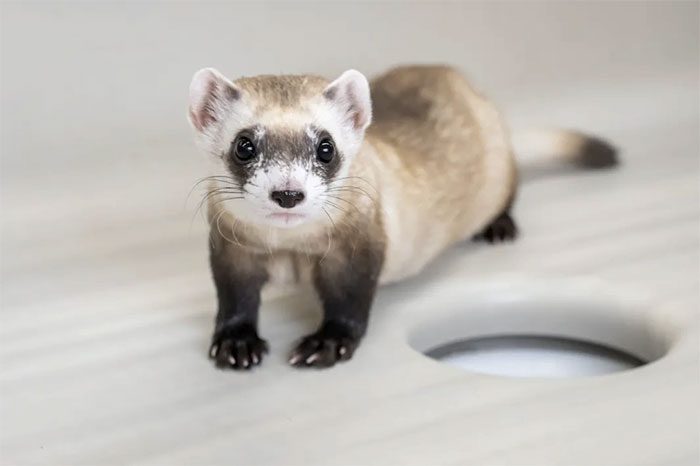The U.S. Fish and Wildlife Service (FWS) has announced that scientists have successfully cloned two black-footed ferrets from preserved tissues stored in a frozen state.
This marks the second and third instances of cloning in the black-footed ferret species, following the birth of the first cloned individual in December 2020.
The black-footed ferret is an endangered species, and scientists hope that these new cloned individuals will help increase the genetic diversity of the population.
The limited genetic diversity of the current black-footed ferret population makes them susceptible to diseases and genetic defects, while also reducing their reproductive rates, which hampers their ability to adapt to wild environments, complicating conservation efforts.

Noreen, one of the two black-footed ferrets born through cloning (Photo: Rohan Patel).
“Genetic diversity is crucial for resilience to environmental changes,” shared Megan Owen, Vice President of Conservation Science at the San Diego Zoo, an organization involved in the cloning efforts. “Essentially, this is considered the raw material for adaptive evolution.”
The two new cloned individuals have been named Noreen and Antonia. Both currently exhibit good health and have reached developmental and behavioral milestones as expected by scientists.
Noreen was born at the National Black-footed Ferret Conservation Center in Colorado, while Antonia was born at the Smithsonian Conservation Biology Institute and National Zoo in Washington, D.C.
The black-footed ferret is a species native to North America, having existed on the continent for at least 100,000 years. They have long, slender bodies with light-colored fur, but their faces, four legs, and tails are black. This nocturnal mammal digs underground burrows for shelter.
It is estimated that there were between 500,000 to 1 million black-footed ferrets living in the 1800s, ranging from northern Mexico to southern Canada. However, by the 20th century, their numbers sharply declined due to farmers exterminating prairie dogs, the ferrets’ primary food source and a pest to crops. Additionally, various diseases severely impacted the black-footed ferret population.
Scientists once believed the black-footed ferret was extinct by 1979, but in 1981, a farmer’s dog brought home the carcass of a black-footed ferret, prompting scientists to investigate and discover a small population of the species near Meeteetse, Wyoming.
In the following years, scientists captured seven black-footed ferrets and initiated a breeding program to conserve the species. After breeding in captivity, the ferrets were released back into the wild at 34 locations across the United States, Canada, and Mexico. The FWS estimates there are currently several hundred black-footed ferrets living in the wild.
However, this conservation process faces a challenge, as nearly all wild black-footed ferrets are descendants of the seven captured individuals, severely limiting their genetic diversity.
In contrast, the three cloned black-footed ferrets are different. They were cloned from tissue samples frozen since 1988 from a ferret named Willa. This tissue was stored at the San Diego Zoo Wildlife Alliance Biobank.
Willa’s uniqueness lies in the fact that she never reproduced, meaning her genes were never passed on to subsequent generations.
To clone the black-footed ferret, scientists injected a cell from Willa into the egg of a domesticated black-footed ferret.
The first cloned black-footed ferret was born in late 2020 and named Elizabeth Ann. This female ferret is currently being cared for at the National Black-footed Ferret Conservation Center in good health; however, she is unable to reproduce due to ovarian dysgenesis.
According to the FWS, the ovarian dysgenesis is also commonly found in other black-footed ferrets, so researchers do not believe this condition is related to the cloning process.
After Noreen and Antonia, the two new cloned black-footed ferrets mature, scientists will attempt to breed them to enhance genetic diversity for future generations.
In addition to the black-footed ferret cloning project, scientists are also collecting and storing frozen tissue samples of all endangered species in the U.S. This could serve as a valuable resource in the future to combat extinction.


















































